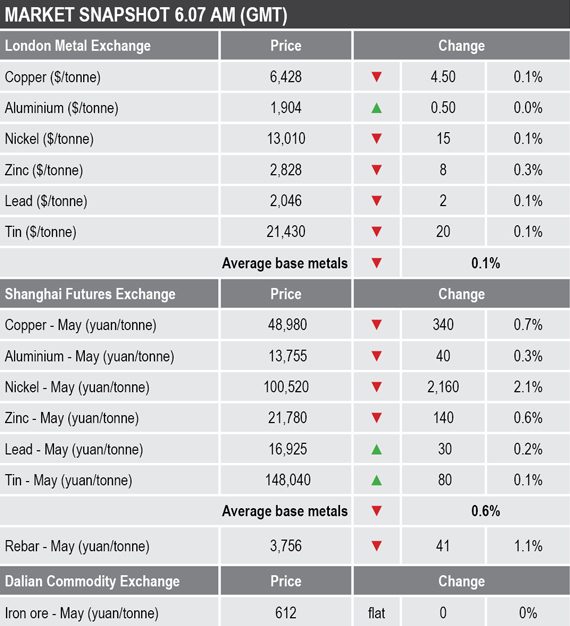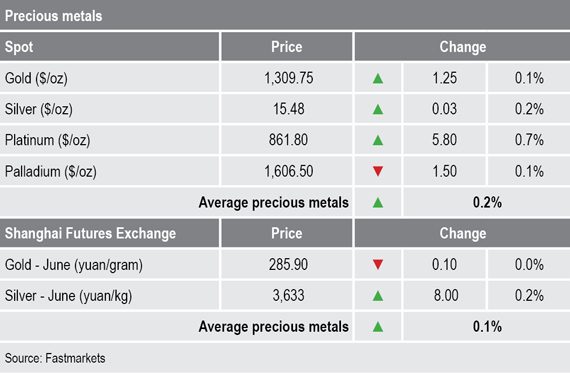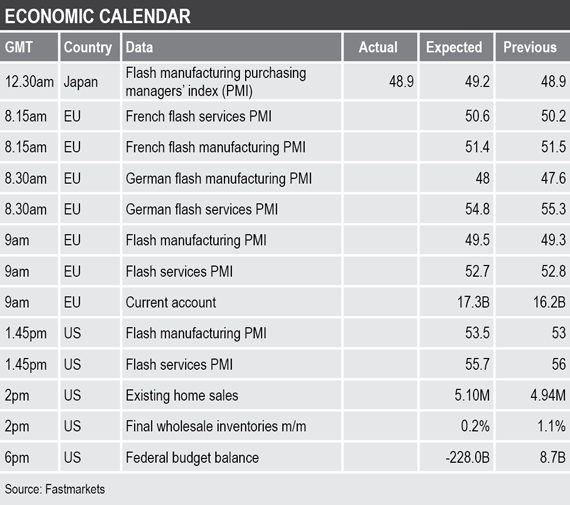The initial weakness seen in the dollar index following the surprisingly dovish tone struck by the US Federal Open Market Committee (FOMC) at the conclusion of their meeting on Wednesday proved to be short-lived.
The dollar index, which gauges the strength of the US dollar against a basket of foreign currencies, was recently quoted at 96.29 after having been as low as 95.74 on Wednesday.
The renewed strength in the US currency has brought with it selling pressure across the base metals.
The three-month zinc price on the LME led the decline with a 0.3% drop, while the rest barring aluminium were down by 0.1%. The three-month aluminium price was little changed from its previous close at $1,904 per tonne. On average, the LME base metals complex was down by 0.1% this morning.
In terms of volume, 4,129 lots had traded on LME Select as at 6.07am London time, considerably lower than this week’s average of 5,684 lots.
With the rebound in the dollar index, spot precious metals were only mildly positive this morning with an average gain of 0.2% across the complex. Gold was recently at $1,309.75 per oz, silver was at $15.48 per oz, platinum has held onto most of this week’s gains at $861 per oz and bullish palladium remains near all-time highs at $1,606.50 per oz.
In China, base metals prices on the Shanghai Futures Exchange were broadly weaker with average losses of 0.6%. The May nickel contract led the decline with a drop of 2.1%, followed by a 0.7% dip in May copper, while May zinc and aluminium were down by 0.6% and 0.3% respectively. May lead and tin bucked the general weakness to record marginal gains of 0.2% and 0.1% respectively.
The spot copper price in Changjiang was at 49,920-50,080 yuan ($7,458-7,482) per tonne on Friday morning, compared with 50,030-50,370 yuan per tonne on Thursday, while the LME/Shanghai copper arbitrage ratio was at 7.51 after being at 7.58 at a similar time yesterday.
Other metals in China were mixed; the May steel rebar contract on the SHFE was down by 1.1% to 3,756 yuan per tonne, compared with 3,817 yuan per tonne at Thursday’s close, while the May iron ore contract traded at Dalian Commodity Exchange was unchanged at 612 yuan per tonne.
In other markets, the spot Brent crude oil price was up by 0.32% at $67.96 per barrel recently, compared with $68.60 per barrel at a similar time on Thursday.
The yield on US 10-year treasuries was weaker, down by 0.5% to 2.5230%, while the German 10-year bund yield has recovered to 0.0500%, following from the two-year low of just 0.034% seen on Thursday.
The overnight performance of US equity markets remain supportive of risk sentiment with solid gains made by the Dow Jones Industrial Average, up by 0.84%, and the S&P 500 Index closing 30 points higher at 2,854. European equities were less impressive on Thursday with the German Dax down by 0.46% and the Euro Stoxx off by 0.15% but the FTSE 100 surprised to the upside with a gain of 0.88%.
Despite the mixed performance by western equity markets on Thursday, risk appetite in Asia remained skewed to the upside on Friday, with the Nikkei (+0.09%), Topix (+0.17%), Hang Seng (+0.03%) all higher, though China’s CSI 300 Index (-0.08%) was marginally lower.
In currency markets, the rebound in the dollar has acted as a headwind for the other currencies we follow; the Euro was recently lower at 1.1387, while the Australian dollar (0.7113) and the Japanese yen (110.76) have also weakened. Meanwhile, the pound sterling, recently at 1.3148, remains under the influence of the ongoing confusion surrounding the United Kingdom’s exit from the European Union in the process known as Brexit.
In data already out on Friday, Japan’s flash manufacturing purchasing managers’ index (PMI) came in unchanged at 48.9 in March, but this was below an expected 49.2. Later, there is a slew of manufacturing and services PMI data from Europe and the US of note. Other notable US data includes existing home sales, final wholesale inventories and the federal budget balance.
Considering where base metals prices were in early January 2019, the rebound momentum looks set to stay for now. Copper, nickel, zinc and tin prices on the LME have fared better than the others due to their robust fundamental backdrop and tight micro-dynamics. Meanwhile, aluminium and lead are merely getting by as overall sentiment from speculators remains fairly negative.
Still, base metals prices are consolidating their recent gains and there has yet to be any sign of a significant correction. With the new Chinese value-added tax rates to come into effect from April 1, this may provide the LME base metals with the much-needed boost to continue higher.
At the same time, precious metals are holding up rather well despite the recovery in the dollar index. Brexit uncertainty, fresh concern over sluggish US economic growth, an extremely dovish Federal Reserve and persistently weak data from China has encouraged risk-averse investors to diversify their portfolios.



